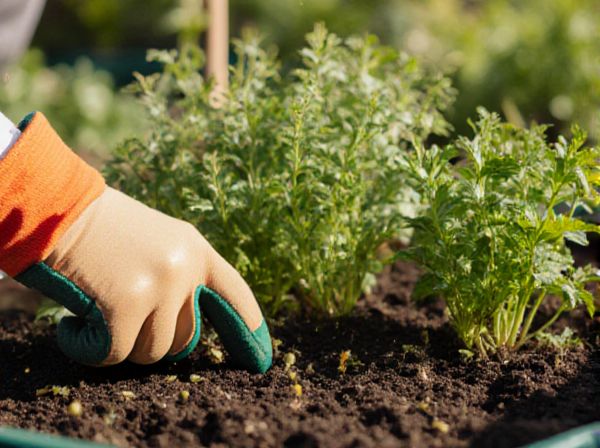
Self-seeding herbs vs Annual herbs Illustration
Self-seeding herbs naturally disperse their seeds, allowing new plants to grow year after year without replanting, making them a low-maintenance choice for continuous harvests. Annual herbs complete their life cycle in one growing season, requiring gardeners to sow seeds or plant new seedlings each year for fresh crops. Understanding the difference between self-seeding and annual herbs can optimize garden planning and ensure a steady supply of fresh flavors.
Table of Comparison
| Feature | Self-Seeding Herbs | Annual Herbs |
|---|---|---|
| Definition | Herbs that naturally drop seeds and regrow year after year. | Herbs that complete their life cycle in one season and do not reseed. |
| Examples | Basil, Cilantro, Dill | Parsley, Chives, Mint |
| Growth Cycle | Perennial or self-regenerating via seed. | Complete life cycle within one growing season. |
| Maintenance | Low; minimal replanting due to natural reseeding. | High; requires replanting every year. |
| Harvest Period | Extended; multiple harvests over seasons. | Limited to one season. |
| Suitability | Best for sustainable, low-maintenance gardens. | Ideal for controlled, seasonal herb production. |
Understanding Self-Seeding Herbs
Self-seeding herbs like cilantro and parsley naturally drop seeds that germinate year after year, reducing the need for replanting and ensuring a continuous supply. These perennial growth habits contrast with annual herbs such as basil, which complete their life cycle in one season and require reseeding each year. Understanding the self-seeding process can optimize garden planning by promoting sustainable herb growth and reducing maintenance efforts.
What Are Annual Herbs?
Annual herbs complete their entire life cycle, from germination to seed production, within a single growing season, typically lasting less than one year. These herbs, such as basil, cilantro, and dill, require replanting each year as they do not survive frost or harsh winter conditions. Annual herbs are favored for their rapid growth and abundant flavor during their limited lifespan but depend on ongoing cultivation for continuous harvests.
Key Differences Between Self-Seeding and Annual Herbs
Self-seeding herbs naturally disperse their seeds to grow new plants year after year without replanting, whereas annual herbs complete their life cycle in a single growing season and require replanting each year. Self-seeding herbs like cilantro and dill can create a persistent herb garden with minimal maintenance, while annuals such as basil and chives offer reliable growth and predictable harvests during their one-season lifespan. Understanding seed dispersal and lifecycle duration helps gardeners optimize herb cultivation strategies for sustainability and productivity.
Top Self-Seeding Herbs for Edible Gardens
Top self-seeding herbs for edible gardens include basil, cilantro, and dill, which naturally drop seeds to ensure new plants each growing season without replanting. These perennial or reseeding annual herbs thrive in diverse climates, providing a continuous harvest of fresh leaves and seeds. Incorporating self-seeding herbs reduces maintenance, enhances garden biodiversity, and supports sustainable edible landscaping.
Popular Annual Herbs for Culinary Use
Popular annual herbs for culinary use include basil, cilantro, and dill, prized for their robust flavors and fast growth cycles. These herbs complete their life cycle in one growing season, providing fresh, aromatic leaves ideal for seasoning a variety of dishes. Gardeners often replant annual herbs each year to maintain a steady supply of vibrant, tender herbs for cooking.
Advantages of Growing Self-Seeding Herbs
Self-seeding herbs like cilantro, dill, and chives offer the advantage of natural regeneration, reducing the need for yearly replanting and ensuring a continuous harvest. These herbs adapt to local conditions, enhancing resilience against pests and diseases while saving gardeners time and resources. Their ability to drop seeds and grow season after season provides a sustainable option for maintaining a thriving edible garden with less maintenance.
Benefits and Challenges of Annual Herbs
Annual herbs offer rapid growth and high yield within a single growing season, making them ideal for quick harvests and seasonal flavor variety. They require frequent replanting, which demands consistent attention and resources but allows for crop rotation and pest management. Their short lifecycle limits long-term soil stabilization and continuous herb availability compared to perennial or self-seeding options.
Maintenance and Care Tips for Both Herb Types
Self-seeding herbs like cilantro and dill require minimal maintenance as they naturally reseed each season, reducing the need for replanting and allowing for continuous harvests with proper thinning and watering. Annual herbs such as basil and chervil demand consistent care including regular watering, pruning, and replanting each year to maintain optimal growth and flavor. Both herb types benefit from well-drained soil and full sun exposure, but self-seeding herbs offer ease by regenerating themselves, while annuals need more hands-on attention for propagation and upkeep.
How to Incorporate Self-Seeding and Annual Herbs in Garden Design
Incorporating self-seeding herbs such as cilantro, dill, and chives alongside annual herbs like basil, parsley, and thyme can create a dynamic and sustainable garden layout that balances continuity with seasonal variety. Strategically position self-seeding herbs in borders or naturalized areas to allow effortless regeneration, while placing annuals in raised beds or containers for controlled growth and easy harvesting. This combination enhances biodiversity, reduces replanting effort, and ensures a steady supply of fresh herbs throughout the growing season.
Choosing the Right Herbs for Your Edible Garden
Self-seeding herbs like cilantro and parsley naturally propagate, providing continuous harvests year after year with minimal effort, making them ideal for sustainable edible gardens. Annual herbs such as basil and dill complete their life cycle within a single growing season, requiring reseeding or replanting to maintain a steady supply. Selecting the right combination of self-seeding and annual herbs enhances garden productivity, ensuring a diverse and reliable source of fresh flavors throughout the seasons.
Self-seeding herbs vs Annual herbs Infographic

 gardendif.com
gardendif.com